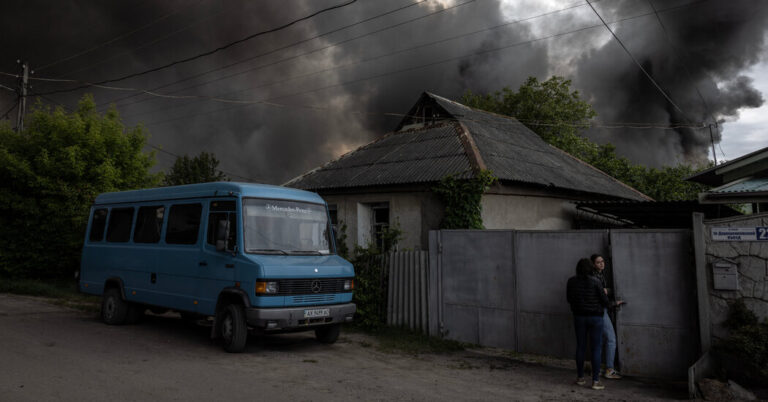Russian forces continued to press a grinding advance on Saturday into northeastern Ukraine, moving closer to a village about 10 miles from the outer ring of Kharkiv and raising fears that the city, Ukraine’s second largest, could soon be within range of Russian artillery.
The Ukrainian Army said on Saturday that Russian troops had tried to break through its defenses near the village of Lyptsi, which lies directly north of Kharkiv. It said the attacks had been repelled, but maps of the battlefield compiled by independent groups analyzing publicly available video of the fighting showed that Russian troops had almost reached the outskirts of the village.
Ukraine’s Khartia Brigade, which is defending Lyptsi, posted a video on Telegram on Friday afternoon that it said showed Russian soldiers advancing on the village on foot, and attacking in small groups between tree lines. The brigade said it had targeted the Russians with rockets, forcing them to withdraw.
Russian troops opened a new front in Ukraine’s northeast a week ago, surging across the border and quickly capturing about 10 settlements in what Ukrainian officials and military analysts described as an attempt to stretch Ukraine’s already outnumbered forces.
The Khartia Brigade, for example, has been redeployed from another hot spot on the front, around Ocheretyne, a village in the southeast. Russian forces captured Ocheretyne last month, creating a breach in Ukrainian defenses.
But experts say that another, perhaps more immediate, goal for Russia could be to advance deep enough into Ukrainian territory to push Kyiv’s forces away from the border, creating a buffer zone that would prevent the Ukrainians from targeting Russian towns and cities with artillery. President Vladimir V. Putin of Russia said on Friday that that was the goal of the current offensive.
A buffer zone might also allow Russian forces to get close enough to Kharkiv to pound it with artillery shells, escalating Moscow’s campaign to inflict hardship on the city’s inhabitants by hitting residential neighborhoods with airstrikes and targeting its power stations to cut off electricity.
“Such a buffer zone of 10 to 15 kilometers for sure would create a problem for Kharkiv,” said Mykola Bielieskov, a military analyst at the government-run National Institute for Strategic Studies in Ukraine.
Further Russian advances would return Kharkiv, now home to some 1.2 million people, to the situation it faced in the first months of the war. In 2022, Russian troops reached the outer ring of the city, prompting hundreds of thousands to flee.
Kharkiv’s mayor, Ihor Terekhov, has described Russia’s advance toward the city as designed to sow chaos and panic. But he repeated this past week that there were no plans to evacuate the population. Instead, the city has served as a temporary home for thousands of Ukrainian civilians who have fled the fighting in the region, from villages like Lyptsi or Vovchansk, further east.
Kharkiv, however, is not entirely safe. In recent months, Russia has increasingly targeted the city with powerful guided missiles known as glide bombs, which can deliver hundreds of tons of explosives, and S-300 antiaircraft missiles, which Moscow is now using to attack targets on the ground.
“The time it takes S-300 missiles to reach Kharkiv — it’s just minutes,” Ilya Yevlash, a spokesman for the Ukrainian Air Force, said in an interview this month. “There’s no time to react to these threats.”
Only American-made Patriot air defense systems can intercept S-300 missiles fired at short range, Mr. Yevlash said, and Ukraine does not have enough of them. “We can count them on the fingers of one hand,” he said.
Ukrainian officials have urged their Western partners to send more. “We extremely need the air defense to protect Kharkiv” and other cities in Ukraine’s northeast, Andriy Yermak, the head of President Volodymy Zelensky’s office, said in an interview with The New York Times this past week. “It’s time.”
Mr. Putin said on Friday that Russian forces had no plans to take the city itself. Military experts also say that Russia lacks the forces to conduct such an operation.
Getting closer to Kharkiv, though, will not be an easy task.
Russian forces have so far pushed through largely depopulated and poorly fortified areas. Entering Lyptsi, which had a prewar population of 4,000 and is dotted with houses and buildings, will force Russian troops to engage in more difficult street fighting.
Emil Kastehelmi, an analyst for the Finnish Black Bird Group, which assessed satellite images and footage of the battlefield, noted on the social platform X that “a long chain of villages” separates Lyptsi from Kharkiv. Advancing through them one by one, he said, “would force the Russians to fight through over 17 kilometers of built areas.”
In an interview with the news agency Agence France-Presse on Saturday, Mr. Zelensky said he expected Russia to step up its offensive in the northeast, possibly by opening new fronts elsewhere, such as in the Sumy region, north of Kharkiv.
That would further stretch the Ukrainian military, which already has to defend a more than 600-mile front line. In an attempt to address the shortage of troops, the Ukrainian government has passed a series of measures to widen the pool of people who can be drafted.
A mobilization law passed last month, which includes incentives for volunteers and new penalties for those trying to evade conscription, came into force on Saturday. Ukrainian men now have two months to update their personal details at military recruitment centers or online, to make it easier for the authorities to identify potential conscripts.
Matina Stevis-Gridneff contributed reporting from Brussels.

